ushiku daibutsu
Ushiku Daibutsu and Other Great Buddhas of Japan!

Tokyo Terry
Posted on May 14, 2024
Share:
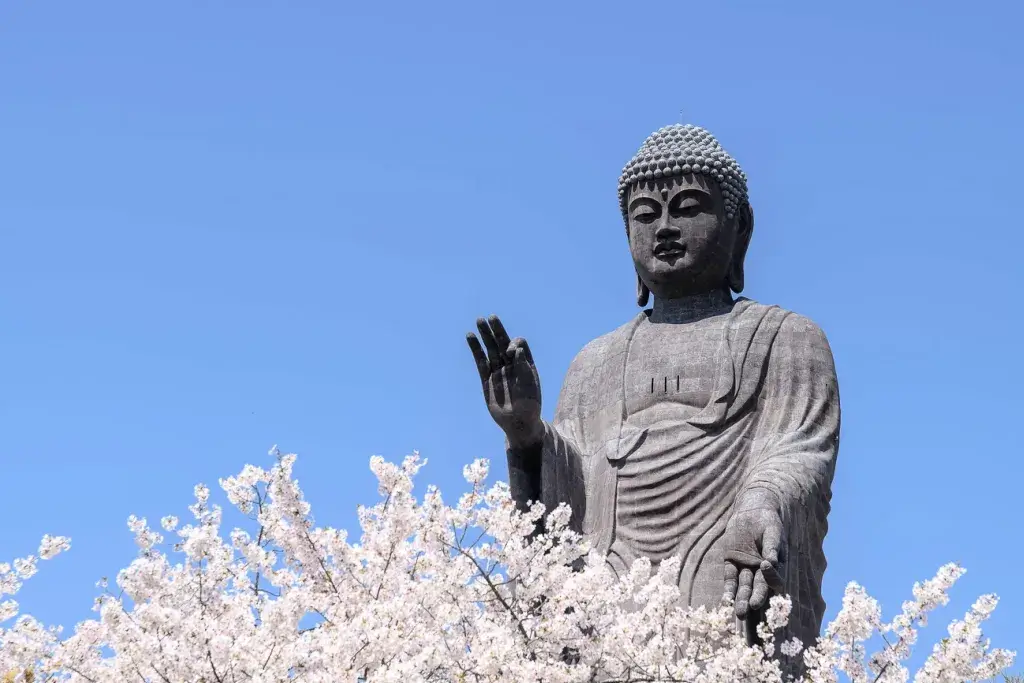
The top of the standing Ushiku Daibutsu Buddha is over 100 meters off the ground. Some are centuries old, and others were erected in the 1800s. They are places of pilgrimage – both for worship and simply for admiring their beauty. Let’s look at some amazing Buddha statues across Japan.
Ushiku Daibutsu (牛久大仏)
The “Great Buddha of Ushiku” is located in Ushiku, Ibaraki Prefecture, near a “Pure Land” Jodo Shinsu temple. It is only a 20-minute bus ride from Ushiku Station on the JR Joban Line. At 120 meters (394 feet) tall, it isn’t the tallest statue in the world but the tallest daibutsu (large Buddha statue). It is also the largest bronze daibutsu in Japan.
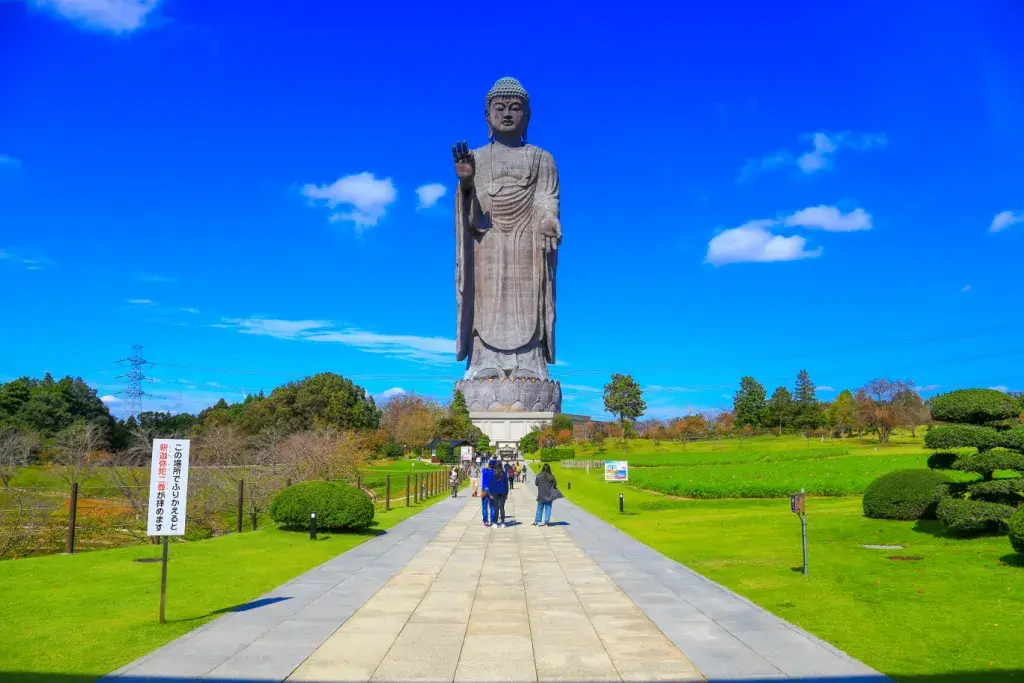
Every ten meters in height represents one of Buddha’s twelve beams of light. The grounds also contain over 100 cherry blossom trees and a large pond that symbolizes the source of all life. After the cherry blossoms bloom in April, Phlox flowers (“pink moss”) cover the grounds in May. There is also a small animal park that allows feeding of the animals.
Visitors can enter the bronze statue for a panoramic view of the surrounding country from 85 meters above the ground. The “World of the Lotus Sanctuary” Hall on the fifth floor contains 3,400 statues of Buddha. There is also a souvenir shop to commemorate your trip. The founder of the Jodo Shinsu sect believed that faith, not actions, would allow one to achieve the highest enlightenment. This state represents the “Pure Land.”
Nara Daibutsu (Great Buddha of Nara)
Todaiji Temple in Nara City, Nara Prefecture, is casually called the “Great Eastern Temple.” Its 15-meter-tall (50-foot) bronze daibutsu is the second-largest in Japan. It was originally erected in 752 CE but has been remade several times due to earthquake damage. This portrayal sits cross-legged, palm-raised, and facing outwards. Nara was once the capital of Japan, so Todaiji Temple is considered the head Buddhist temple in the country.
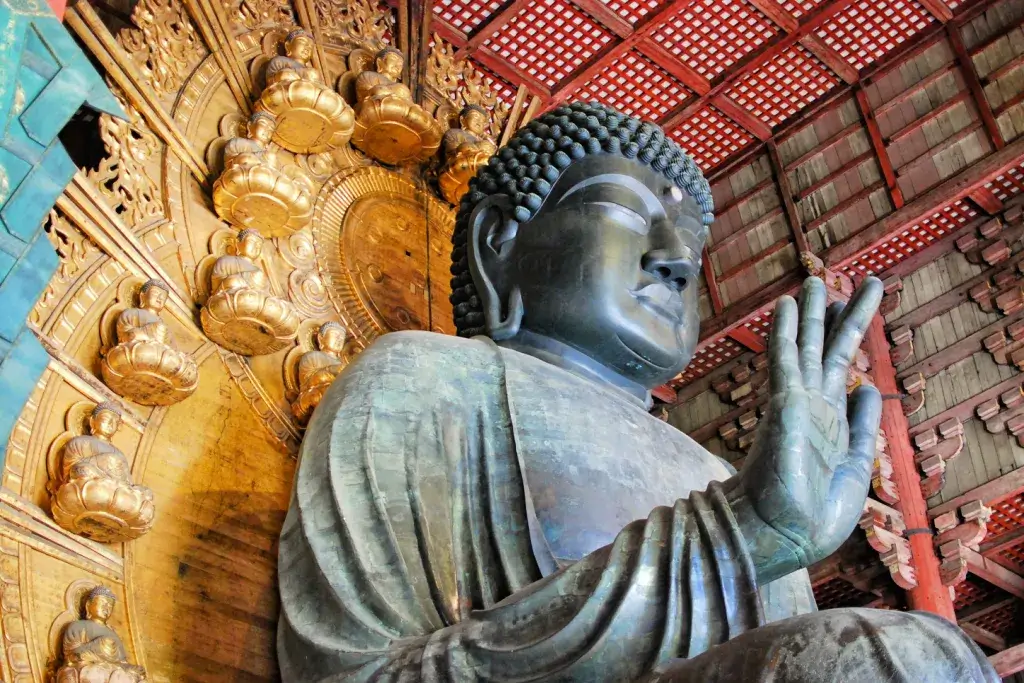
There are other representations of the deity in Daibutsuden Hall, which was once the largest wooden building in the world. Other nearby attractions include Nandaimon Gate and its two “Nio Guardian Kings”, which are Japanese national treasures. The temple’s location in Nara Park means it is also close to Todaiji Museum, as well as Kaidandol, Hokkedo, and Nigatsudo Halls. The area is only a 30-minute walk from Kintetsu Nara Station.
Are you looking for some amazing snacks while checking out breathtaking Buddha statues? Check out Sakuraco! Sakuraco delivers traditional Japanese snacks, teas, and sweets from local Japanese makers directly to your door.
Kamakura Daibutsu (Great Buddha of Kamakura)
The Great Buddha of Kamakura has a long history of reconstruction. After completing the original wooden version in 1243, a storm damaged it five years later. Craftsmen then remade it out of bronze and placed it in a large hall to protect it from the elements. Over the centuries, storms and tsunamis destroyed this hall three times.
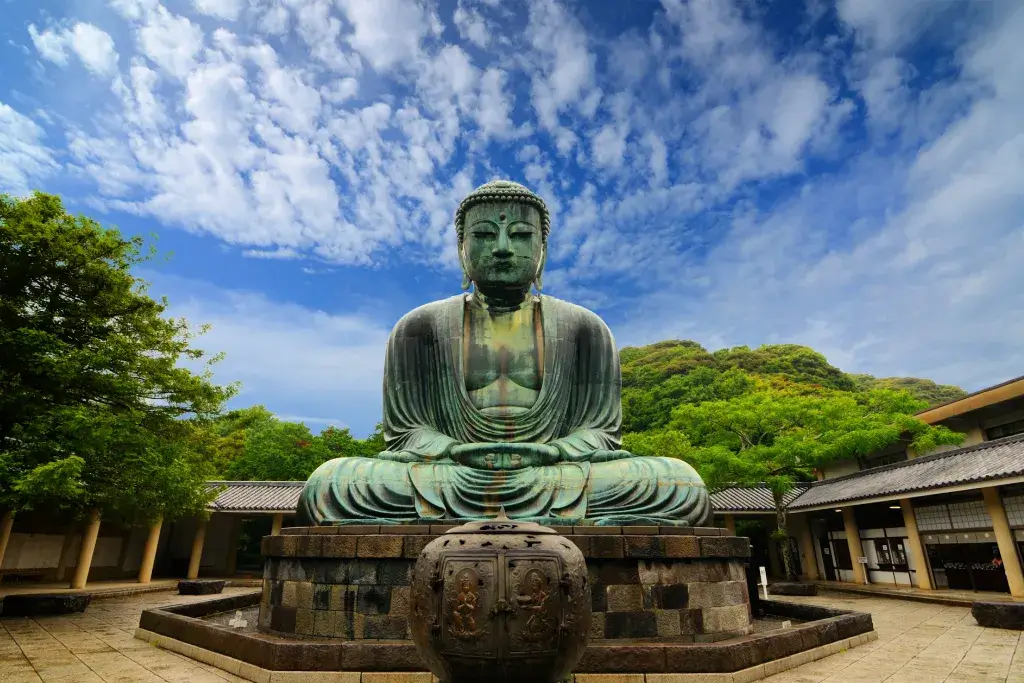
The piece now sits outdoors in a courtyard. Like Nara City’s Daibutsu, it also sits with its hands lying on its lap. It is the third-tallest bronze Buddha in Japan at about 13 meters (43 feet) high. This bronze likeness is popular for its beauty and convenient location near Tokyo. Visitors can also enter the Kamakura Daibutsu. The nearest station is Hase Station on the Enoden railway line, only 10 minutes by foot.
Tokyo Daibutsu
The Jorenji Temple in Itabashi City was built in the 1400s, but the statue is a relatively recent addition. It was constructed in 1977 as a memorial for victims of the 1923 Great Kanto Earthquake and 1945 Tokyo bombings. It also protects Tokyo and hopes for a world of gratitude in the future. For this reason, it is based on the Amida Buddha, who created paradise to save people from suffering.
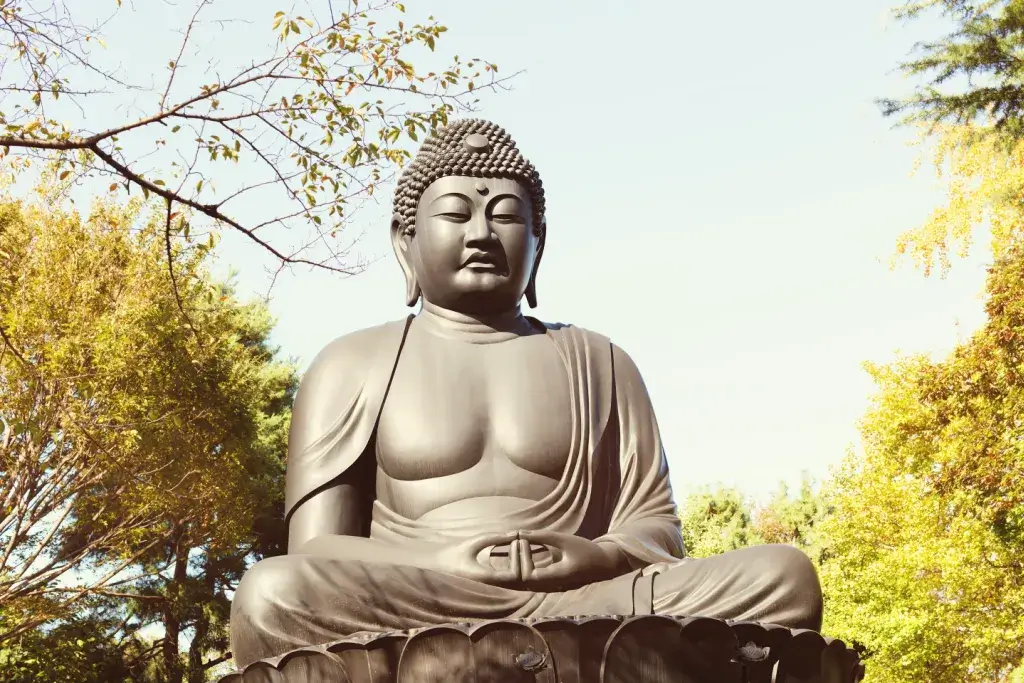
This 10-meter-high (33-foot) sculpture stands among other exciting figures. It is near the Itabashi Historical and Art Museums, Akatsuka Botanical Gardens, and Akatsuka Joshi Park. The area is a 20-minute stroll from Narimasu Station on the Tobu Tojo Line.
Hill of the Buddhas
This 13-meter-tall (43-foot) stone icon is in Sapporo, Hokkaido Prefecture. From the entrance gate, only the head of the statue is visible, protruding from the hill in which it resides. Visitors approach via a long, straight walkway beneath a shallow pool. Then, a 40-meter-long tunnel connects the cave-like entrance in the hillside to Buddha’s chamber. Because of the tunnel’s low ceiling, the seated figure only comes into full view when standing at its base. Only then can the fantastic sight of its head silhouetted against the sky be appreciated.
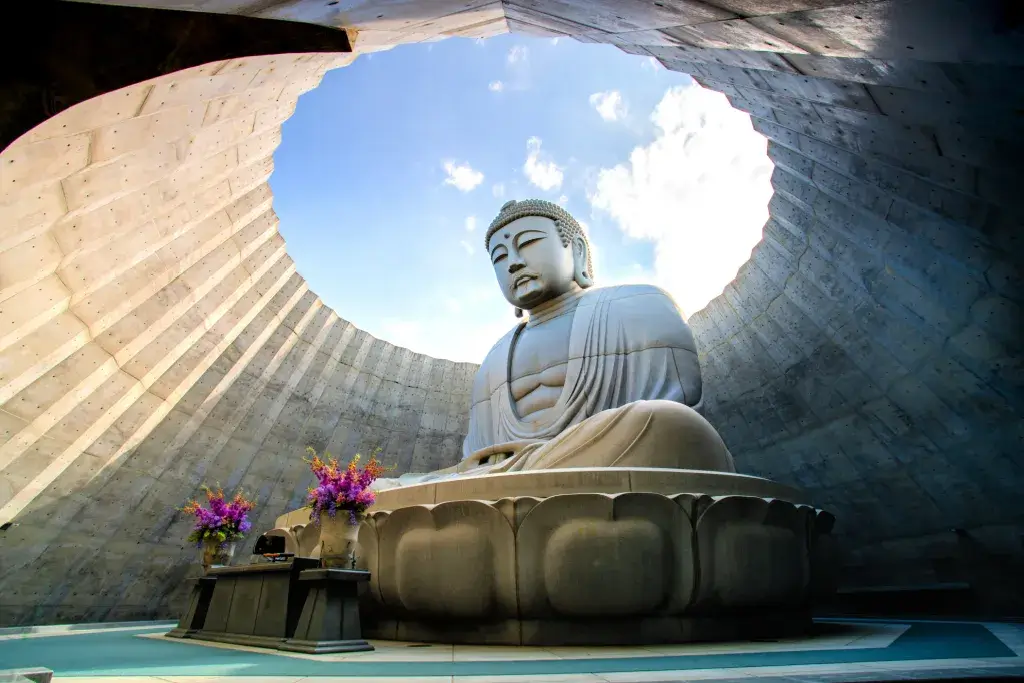
In July, the hill and surrounding 180 hectares of 100,000 purple flowers. It also has full-sized replicas of Stonehenge and Eastern Island Maori heads nearby. The entire concept was the idea of Tadao Ando, a famous Japanese architect. This site is located in Makomanai Takino Cemetery, so it is not a place of worship but one of mourning. You can take pictures there but do not run around or distract others. And the statue cannot be touched. The Chuo bus regularly departs from Makomanai station to the Takino Reien bus stop.
Why are statues like Ushiku Daibutsu essential?
Statues like the Ushiku Daibutsu represent tranquility, calmness, and majesty, even in natural and man-made disasters. Damaged, repaired, or even completely replaced, they remain symbols of peace and serenity. They honor those lost in historical tragedies, foster peace, and act as destinations for those on spiritual journeys. Finally, these monuments inspire and provide hope for future generations even when appreciated purely as art. Have you visited any of the other daibutsu in Japan? Which was your favorite? If you have visited any of these destinations, why not share your experience below?

Discover authentic flavors with Sakuraco
Get Sakuraco 

Discover authentic flavors with Sakuraco
Get Sakuraco 
Related Articles

Steam Train in Shizuoka: Riding the Oigawa Railway
For travelers who love history, beautiful views, and cozy retro vibes, this steam train is one of Shizuoka’s most charming treasures, with some of the best views. If you want to know more about this train, keep reading below!

Nara Japan: The Amazing Legend of the Sacred Dragon
In Japanese culture, dragons are spiritual beings that represent strength, prosperity, and a harmonious balance with the natural forces. Nara, Japan, has a unique story associated with sacred ponds and revered shrines throughout the region.

Nambu Tekki: Morioka’s Amazing Iron Craft
In the historic city of Morioka, Iwate Prefecture, a craft with over 400 years of history continues to captivate with its rustic beauty and practical charm. Nambu tekki, or Nambu cast iron, refers to traditional ironware, such as teapots, kettles, and decorative pieces, that embody the spirit of Tohoku craftsmanship.

Ebisu: The Cheerful Guardian of Luck and Prosperity
Religion in Japan involves a dizzying array of spirits and beings. These gods are inspired by ancient tales and used to symbolize nature’s bounty. However, they also profoundly impact daily life and are often sought out for help in challenging times



